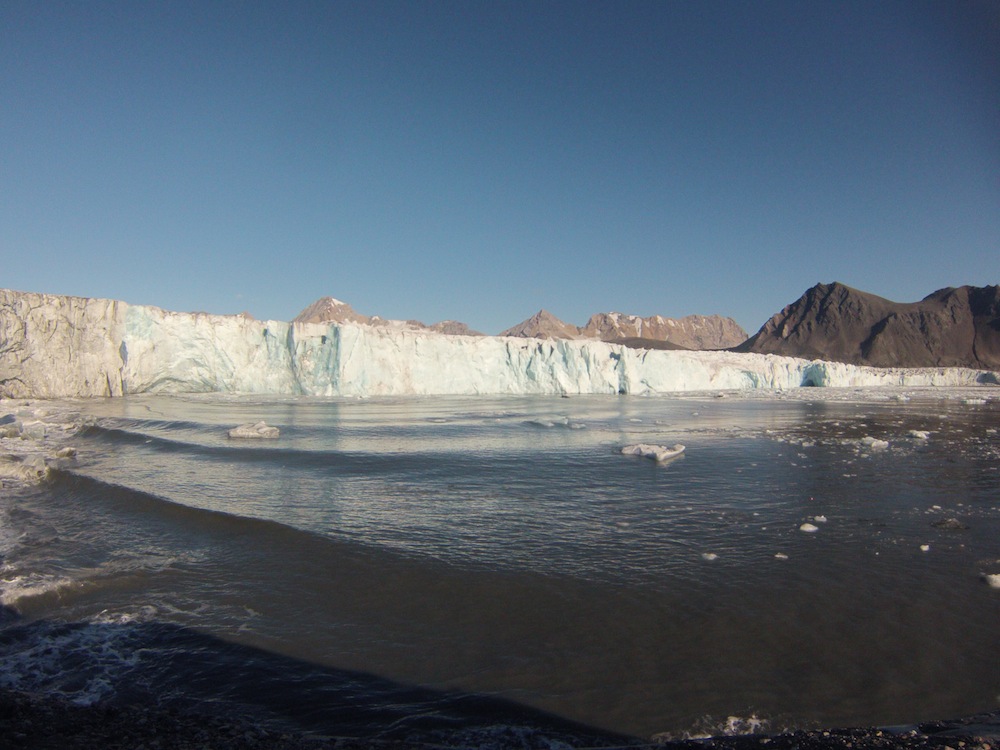Glacier's Groans Can Pinpoint Iceberg Calving

To estimate the amount of ice sloughing off glaciers and falling into rising seas, scientists may simply need to listen.
New research finds that sound recordings can not only capture the timing of iceberg calving, but can also help determine whether that ice is breaking off above or below the waterline, and how it is doing so. Ultimately, just by using underwater microphones, researchers hope to be able to gauge how quickly a glacier is losing ice.
"Melting glaciers contribute to global sea level rise, and this contribution is really substantial," study leader Oskar Glowacki, a researcher at the Polish Academy of Sciences' Institute of Geophysics, told Live Science. "It's about 20 to 25 percent. Just imagine — people living on islands and coastal areas are in danger." [Video: Listen to the distinctive sounds of iceberg calving events]
Goodbye, glaciers
And that danger is poorly understood, Glowacki said. Getting close to a calving glacier is perilous work. There are unpredictable seas to contend with, as well as dangerous weather and, of course, all that falling ice.
Until recently, scientists have had to content themselves with satellite imagery in an attempt to understand how quickly glaciers and ice sheets are losing ice. But the smallest objects satellites can spot are about 160 square feet (15 square meters) in size.
"We can say that's enough to analyze the biggest glaciers and ice caps all around the world, but it's not enough to measure the smaller ones," Glowacki said.
Sign up for the Live Science daily newsletter now
Get the world’s most fascinating discoveries delivered straight to your inbox.
That's where acoustics come in. When ice falls from a glacier's face, it makes noise that travels efficiently through the water. Underwater microphones that can pick up these undersea noises are inexpensive and safe to deploy, Glowacki said.
In August 2013, working out of the Polish Polar Station on the Norwegian archipelago of Svalbard, Glowacki and his colleagues deployed acoustic buoys near Hans Glacier. The researchers also set up cameras to take time-lapse photography of the glacier so they could correlate images with sound.
Over several days, the team captured 20 iceberg calving events. Of these, 15 were typical icefalls, in which chunks of ice dropped off the glacier above the waterline and crashed into the water below. Two were icefalls with contact, meaning the ice slid down the face of the glacier, touching the glacial face. Another three were submarine calving events.
"Here, we can hear a lot of cracks underwater, and these cracks are propagating, and then the blocks are detaching from the deepest part of the ice wall," Glowacki said. "It's very spectacular."
Sound of ice
By comparing the sound recordings with time-lapse video, the researchers were able to match up certain sounds with certain types of iceberg calving. For example, icefalls that slide and occur above the water create more high-frequency sounds from the friction of ice against ice. In underwater icefalls, Glowacki said, low-frequency sounds are more frequent. The researchers can even differentiate among the sounds made when the ice starts to crack, when it detaches and when it begins to surface, creating waves and splashes.
Being able to tell these events apart is the first step in estimating ice loss using sound alone, Glowacki said.
"If we can differentiate calving events, we can better correlate our acoustic signal with the amount of ice detached from the glacier," he said. The team is currently recording the Hans Glacier via an acoustic buoy — assuming that buoy has not been destroyed by a floating iceberg, which can be a problem, Glowacki said. If the buoy is intact, however, it should return up to six months of glacier sounds for the researchers to study. Ultimately, the team hopes to acoustically monitor glaciers in other locations, including Greenland and Alaska.
The research was published Feb. 2 in the journal Geophysical Research Letters.
Follow Stephanie Pappas on Twitter and Google+. Follow us @livescience, Facebook & Google+. Original article on Live Science.

Stephanie Pappas is a contributing writer for Live Science, covering topics ranging from geoscience to archaeology to the human brain and behavior. She was previously a senior writer for Live Science but is now a freelancer based in Denver, Colorado, and regularly contributes to Scientific American and The Monitor, the monthly magazine of the American Psychological Association. Stephanie received a bachelor's degree in psychology from the University of South Carolina and a graduate certificate in science communication from the University of California, Santa Cruz.









